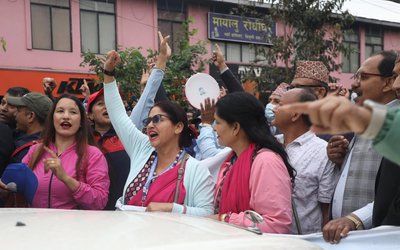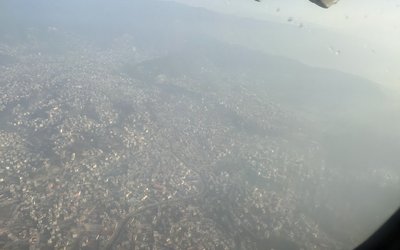
At a time when the growing population, industrialization and haphazard construction of monasteries inside Lumbini are ruining the significance of the birthplace of Shakyamuni Buddha, a group of Korean architects has presented a new Master Plan for Lumbini World Peace City with support from Korean International Cooperation Agency (KOICA).
Despite being a world heritage site and sacred place for Buddhists around the world, the government encouraged industries to come up in and around Lumbini. More than half a dozen of cement industries and a number of mosques have been constructed in the sacred surroundings.
One of the Special Economic Zones lies in the areas.
The reason behind the present chaos in Lumbini is the failure of Nepal government and Lumbini Development Trust to implement the first Lumbini Development Master Plan designed by Japanese architect Kenzo Tange.
Supported by KOICA, the new Master Plan for Lumbini World Peace City or Lumbini Viswa Shanti Nagrama aims to preserve Lumbini by developing the place as a spiritual and sacred place.
Centered around the Maya Devei Temple, approximately 8 km x 8 km with the projected population of 220,000, the new plan proposes many reforms to accommodate all different Buddhist sects.
Backed by the UN and designed by world-renowned Japanese architect Kenzo Tange in 1978, the first master plan provided the outline for preserving the ancient ruins as well as turning an inaccessible, barren site into a place for pilgrimage.
However, due to the negligence of the successive governments and other stakeholders, the development works that should have been completed as per the Lumbini Development Master Plan are still in limbo. Conflict among Buddhist sects and monks is also responsible to outpace the implementation of the master plan.
Although the exploration of the Buddha’s birthplace took a new turn when the first UN secretary General U Thant, a Burmese Buddhist, visited the site in 1967, the place is yet to develop as its own spiritual significance. Another Asian Ban-ki Moon, a Korean whose mother is reportedly a devout Buddhist, is in the helm of the world body now.
Prepared by a group of Korean architects under the leadership of professor Kwaak Young Hoon, Lumbini World Peace City Preservation and Development Master Plan is likely to address the new problems.
Dividing the eight square km of land into three zones, Tange's plan has an estimated cost of US$ 58 million.
However, the estimated cost of the proposed plan is US$ 762 million with the completion period of 15 years.
“There is the need to have special laws to strictly implement the plan. The first step needed to take is to relocate the industries and call moratorium in selling the land and constructing the building,” said professor Kwaak, Young Hoon in his hour-long presentation.
With support from Ministry of Culture, Tourism and Civil Aviation and Lumbini Development Fund, KOICA is implementing the project. The Master Plan covers approximately 5X5 square miles of Lumbini Area.
The objectives of the master plan include respect for the outstanding universal value of Lumbini, conservation of the cultural, historical and environmental heritages in more appropriate ways, presentation of Metaphysical Foundation Templates for the use in urban design of the Lumbini Viswa Shanti nagar and creation of Lumbini as Buddhist teaching and learning city, world citizens living city, environmentally sustaining city and reflection and meditation city.
Other objectives are to improve the capacity of human resources in the field of urban development and planning in Nepal by sharing Korea’s experiences and knowledge in the field of urban development and planning through the successful implementation of the project.
Implemented through KWAAK E.S.P.R.I, in close work with Lumbini Development Trust (LDT), KOICA has spent about US$ 2 million for the project. During the period, KOICA’s expert team conducted several surveys, interactions with local people and concerned stakeholders and made several presentations to incorporate their feedbacks while developing the Master Plan.
According to KOICA, it has also conducted mid-term reviews and inserted expert’s opinion in the final presentation of the Master Plan.
Minister of Culture, Tourism and Civil Aviation, Bhim Acharya, chief secretary Leelamani Paudyal, secretary of Culture, Tourism and Civil Aviation Sushil Ghimire attended the function. Korean Ambassador to Nepal Choe Young-jin and Buddhist scholars were also present as KOICA made the final presentation of the Master Plan for Luminbini World Peace City.
“The government will seriously consider implementing the master plan prepared by KOICA’s team," said minister of Culture, Tourism and Civil Aviation Bhim Acharya.
Addressing the program, Korean ambassador to Nepal Choe Young-jin said Lumbini is the most important site for Buddhist followers around the world. He expressed the hope that the new master plan will help Nepal to develop Lumbini in proper ways.
Summing up the program, secretary of Ministry of Culture, Tourism and Civil Aviation Sushil Ghimire said that the new master plan prepared by the KOICA’s team will help develop Lumbini in a more organized way.
According a press release issued by KOICA, Korean government and Nepalese government exchanged an MOU for the project on Lumbini in January 2012.
Emperor Ashok made a pilgrimage to Lumbini in 249BC and erected three pillars in the area. The most famous of these stands in Lumbini´s Sacred Garden, near the pond and Mayadevi temple. Chinese travelers Fa Hsein (5th century AD) and Hsuan Tsang (7th century AD) visited Lumbini and left the details. Discovered only in 1895, Khadga Shumsher, the then governor of Palpa, and archaeologist P. C. Mukherji were among the first to excavate the site before the turn of century.
As the world’s spiritual place is in a dire need of planned development, how will the KOICA supported Master Plan fill the deficit of the 3-decade old master plan of Japanese architect Tange remains to be seen.
- NEPAL-THAILAND: Joint Business Council
- Apr 13, 2025
- BIMSTEC SUMMIT: Nepal’s Stand
- Apr 11, 2025
- IME GROUP: Expands Into Paper Industry
- Mar 24, 2025
- CPN UML: Instigated By India
- Mar 23, 2025
- ADB’S CHIEF ECONOMIST: Nepal Reduces Poverty
- Mar 11, 2025















